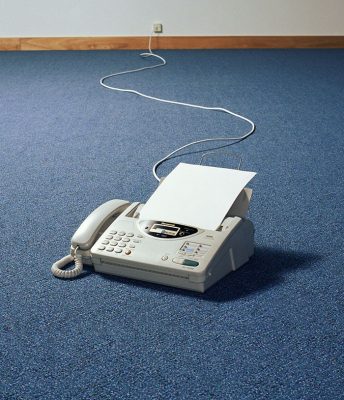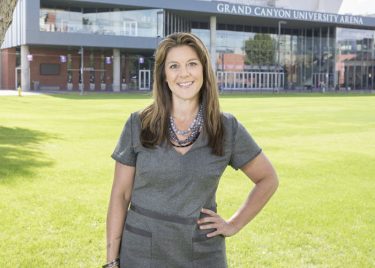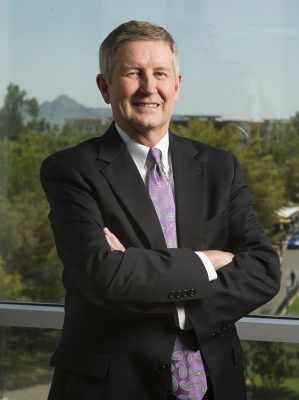
Editor's note: This story is reprinted from the February 2022 issue of GCU Magazine. To read the digital version of the magazine, click here.
By Rick Vacek
GCU Magazine
It all began with fax machines and 25 dial-in modems, routed through a server in San Francisco called ALEC.

University of Phoenix online students in the late 1990s would fax their work to instructors, who would grade it and send it back. Before they could learn the course material, students first had to learn how to navigate news groups, accessed through those modems. Instructors could attach a hyperlink to what they shared, but images and videos weren’t yet in the online education picture.
“You look back on it and you think, ‘Well, that’s primitive,’” said Mark Alexander, Grand Canyon Education’s Senior Vice President of Curriculum and Publishing. “Well, yeah, it was – it was primitive. It was early days. But it worked really well. It was very simple. They kept it very simple and tried to minimize technology problems as much as they could.”
Alexander is one of the many higher education pioneers who followed Brian Mueller from the University of Phoenix when he became Grand Canyon University president in 2008, determined to take online education to even greater heights. To understand how they have turned GCU into a leader in the field, you need to go back to the beginnings 25 years ago.
The timeline below contains the key markers, but the story is best told by the key catalysts, Alexander among them. And the obvious place to start is with the man who has shepherded all this innovation.
THE BIG PICTURE:
Defying the disbelievers
Mueller gets a twinkle in his eye when he talks about any of GCU’s advancements since he arrived in 2008. But online education is one of the biggest bright spots:
“There were a couple things that were interesting about it. One was how strongly we believed in it. We thought we could reach people across the world with innovative ways to deliver education, which could help them move their careers forward.
“And the other thing was how strongly we were criticized by the traditional academic community for delivering education in an online modality. As much as we believed in what we were doing and where it was going, it was received equally poorly on the other side of it.

“But we just kept pushing forward. I remember the level of cooperation that existed between our technology people, our faculty people, our curriculum people, our service people and how we just continued to work together.
“It wasn’t just about the learning. What we realized was that we had to create a learning management platform so faculty and students could come together around good curriculum, but we had to surround it with technology that could provide an equal amount of services.
“We weren’t going to treat those students any differently than a student who would come on campus. So there were writing labs and math labs and there were tutorials created and there was a large electronic library that was created.”
But those innovations wouldn’t have been nearly as effective without what Mueller calls “the single best decision we made” – maintaining small, intimate classrooms. GCU online instructors don’t have hundreds of students who just take multiple-choice exams. The interaction in their manageable groups is far more thought-provoking.
“The ironic thing was, the internet is just a communication tool,” Mueller said. “It’s the greatest communication tool, probably, that has ever been created. Education is a lot about communication, and we fostered the communication in that environment to the extent that faculty members would get to know students very well, students would get to know each other very well, and we would have vibrant discussions.
“As a teacher, when I walk into a classroom, I can do what I can do in an hour or two-hour class session from a discussion perspective. But when that discussion goes from Monday to Sunday night, the depth that you can create in that discussion, the great ideas that you can create, are far greater than you can even do in a physical, brick-and-mortar classroom.”
THE FACULTY:
New way to hire in higher education
More discussions mean the need for a lot more faculty, both fulltime and part-timers known as adjuncts. The revolution in hiring has been led by Kelly Palese, GCE’s Senior Vice President for Faculty Operations:

“Online teaching has become a standard, acceptable way to be involved in higher ed and be able to keep your fulltime job and keep your life the way you have it. Online adjunct teaching has become a sought-after, part-time profession for people.
“Back in the day, you would hear the term ‘professional online adjunct’ and they would adjunct for 10 different schools and try to cobble together a living doing it. But what you really see a lot of now is it is almost a part-time profession or part-time career for people who have zero interest in teaching full-time. They need to keep their full-time jobs, but they are incredibly passionate about the adjunct teaching that they do online.
“What that has done is bring a lot of people into this new adjunct profession, and we’re no longer having to cast this wide net for recruiting purposes because people come to us. They want to give back, they want to share their passion for their discipline, and they choose GCU because they want to do it from a Christ-centered perspective.”
The creation of the Online Full- Time Faculty, bringing them together into the same building, is one of GCU’s two big online education developments, in Palese’s view. The other is the collaboration between Academic Affairs and Student Services.
“Now students are having arms wrapped around them by both faculty and their counselor,” she said.
THE TECHNOLOGY:
From Angel to LoudCloud to Halo
All this wouldn’t have been possible, of course, without continuing innovations in technology, and that’s where Joe Mildenhall, GCU’s former longtime Chief Information Officer, comes in. He was given 90 days in 1998 to expand University of Phoenix’s bulletin board system beyond the maximum of 3,000 users, “and I’ve been on the ride ever since.” Within two years, it had exceeded 50,000:

“They had news group forums, which were threaded, discussion-based forums. A lot of the early bulletin board forums used that for their conversation model. Our first task was moving that class implementation to a better platform that was able to handle a lot more students. But we still relied on that news group-based platform.
“With news groups you had different folders. They would have a folder for general classroom discussion. One for instructor questions. One for assignment submission. Students had rights capability into that folder – they couldn’t look at each other’s assignments.
“We used that for several years. It worked well because it was functional. The other piece of it was that we changed the communication so instead of having the 25 dial-in modems, we actually had them communicating with that classroom through the internet.
“Our students initially were on dialup connections. You didn’t have internet connections through your cable company then. You had dial-up, with all the modem connections. It was fun times.”
Mildenhall has been a key mover in GCU’s graduation in learning management systems, from Angel to LoudCloud to the newest iteration, Halo, which was launched this academic year. The University’s online expertise became even more valuable when the pandemic began in 2019 – the LMS already was a familiar tool for traditional students.
“It really laid the foundation for how quickly we were able to respond to COVID,” he said. “If we would have been disorganized, we would have been in the same boat as most institutions, scrambling to get something built.
“As it was, all the students already had an online classroom. The instructors had integrated it into their teaching of the class. And they just had to be told, ‘OK, it’s all going to be there. You already know where ‘there’ is.’”
THE INSTRUCTION:
Sophistication enters the equation
Alexander began teaching online for University of Phoenix in 2001. Ironically, his family moved frequently when he was a child as his father, Don, taught while earning graduate degrees. Now, Mark was allowed to stay in one place and teach, but he had a lot to learn at first – and so did the students:

“When you first go online, it’s like, ‘Wait, where is everything? How do I do this?’ That was such a critical aspect of it – those counselors helping the students those first times, getting them into class, walking them to class, showing them around. Tech support was critical to those folks, too, because the system wasn’t as holistic and contained as it is now.
“It was very workplace relevant. It attracted people who had maybe started college before and had some number of credits and were needing to come back and finish for whatever reason.
“The biggest piece of the model was that it was practitioner faculty. The person who was teaching was a person like yourself. In a marketing class, we’re not just going to talk about a strategic marketing plan. We’re actually going to have you write one and build one, based on your experience in your company.”
Since coming to GCU, Alexander has played a key role in the conversion to electronic textbooks and in constructing curriculum that is applicable for ground and online students. He has seen it all when it comes to online education. What one word encapsulates it all?
“Sophisticated comes to mind. We’re far more sophisticated today in the way technology is structured and the way we use technology and the way we leverage that. We’re certainly more scalable. More people are doing online learning than they ever thought would be possible.”
Palese came up with the same word for the faculty part of the equation:
“Everything around the faculty process and the faculty experience in the online classroom has just become that much more sophisticated. Recruiting is much more disciplines focused. The ways, the methods, the strategies that faculty use are much more sophisticated.”
And yet Mueller makes it sound so simple, this idea of bringing working adults back to school to create problem solvers:
“We took the learning model that worked in the physical, brick-and-mortar classroom, and we just replicated it online. Rather than bring faculty members and students around great curriculum to a physical, brick-andmortar building, we brought them to the online learning environment.”
And then just kept innovating … for 25 years that changed higher education forever.
Contact Rick Vacek at (602) 639-8203 or [email protected].
****
TECHNOLOGY TIMELINE
University of Phoenix
Late 1990s
ALEC accessed via 25 dial-in modems. Limit: 3,000 students.
Early 1999
Online learning system (OLS) launches. Code name: Groundhog. Target capacity: 20,000 students.
2001
OLS 2001 launches. Target capacity: 100,000 students.
2002
Launches rEsource for online delivery of course materials and electronic textbooks
2005
OLS 3 pushes number of students supported to more than 250,000. Eliminates need to use Outlook Express.
GCU
2009
Angel learning management system (LMS) in use
2011
LoudCloud begins supporting online students
2013
Traditional students added to LoudCloud
2021
Production rollout of Halo
****
Related content:
GCU Today: No Hal-lucination: GCU switches to its own LMS
GCU Magazine: Even online, ground students feel touch of class
GCU Today: Faculty are plugged in for online, blended learning




